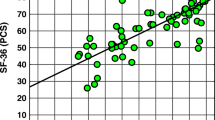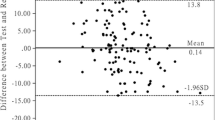Abstract
Purpose
The adaptation of scales to the native language and cultural setting of the patient is essential for obtaining more reliable results in scientific studies. In this study, the rotator cuff-quality of life scale (RC-QoLS) was translated into Turkish, and validity and reliability testing was performed on the scale.
Methods
The scale was first translated into Turkish and then from Turkish to English by another language specialist. Subsequently, the two translations were evaluated by two orthopaedic surgeons who had comprehensive knowledge of English to create the final Turkish version of RC-QoLS. The scale was used for the assessment of 54 patients (average age 56 years) with rotator cuff tear scheduled for surgery. The scale was completed by each patient two times with 1-week interval.
Results
The Cronbach’s alpha coefficients ranged between 0.895 and 0.980 and intraclass correlation coefficients ranged between 0.807 and 0.976, this rendered all domains reliable. The scale gave results very near to those obtained by the original questionnaire with respect to the constructed validity and internal consistency as well as domain relationships.
Conclusions
In general, the Turkish version of the RC-QoLS is a valid and reliable test with high differentiating power that may be used in the evaluation the quality of life of patients with RC tear in patients who are native Turkish speaker. The use of the Turkish version of RC-QoLS may contribute to the making of a more reliable evaluation in the studies on RC problems in the Turkish society.
Similar content being viewed by others
References
Aaronson N, Alonso J, Burnam A, Lohr KN, Patrick DL, Perrin E, Stein RE (2002) Assessing health status and quality-of-life instruments: attributes and review criteria. Qual Life Res 11(3):193–205
Beaton DE, Schemitsch E (2003) Measures of health-related quality of life and physical function. Clin Orthop Relat Res 413:90–105
Byrne BM (2010) Structural equation modeling with AMOS: basic concepts, applications, and programming, 2nd edn. Routledge Taylor & Francis, New York
Gartsman GM, Brinker MR, Khan M, Karahan M (1998) Self-assessment of general health status in patients with five common shoulder conditions. J Shoulder Elbow Surg 7(3):228–237
Hollinshead RM, Mohtadi NG, Vande Guchte RA, Wadey VM (2000) Two 6-year follow-up studies of large and massive rotator cuff tears: comparison of outcome measures. J Shoulder Elbow Surg 9(5):373–381. doi:10.1067/mse.2000.108389
Huber W, Hofstaetter JG, Hanslik-Schnabel B, Posch M, Wurnig C (2005) Translation and psychometric testing of the rotator cuff quality-of-life measure (RC-QOL) for use in German-speaking regions. Z Rheumatol 64(3):188–197
Karanicolas PJ, Bhandari M, Kreder H, Moroni A, Richardson M, Walter SD, Norman GR, Guyatt GH (2009) Evaluating agreement: conducting a reliability study. J Bone Joint Surg 91(Supplement 3):99–106
MacDermid JC, Ramos J, Drosdowech D, Faber K, Patterson S (2004) The impact of rotator cuff pathology on isometric and isokinetic strength, function, and quality of life. J Shoulder Elbow Surg 13(6):593–598
McKee MD, Yoo DJ (2000) The effect of surgery for rotator cuff disease on general health status. Results of a prospective trial. J Bone Joint Surg Am 82-A(7):970–979
Mohtadi NG, Hollinshead RM, Sasyniuk TM, Fletcher JA, Chan DS, Li FX (2008) A randomized clinical trial comparing open to arthroscopic acromioplasty with mini-open rotator cuff repair for full-thickness rotator cuff tears: disease-specific quality of life outcome at an average 2-year follow-up. Am J Sports Med 36(6):1043–1051. doi:10.1177/0363546508314409
Nunnally JC, Bernstein IH (1994) Psychometric theory, 3rd edn. McGraw-Hill, NewYork
Ostor AJ, Richards CA, Prevost AT, Speed CA, Hazleman BL (2005) Diagnosis and relation to general health of shoulder disorders presenting to primary care. Rheumatology (Oxford) 44(6):800–805
Papalia R, Osti L, Leonardi F, Denaro V, Maffulli N (2010) RC-QOL score for rotator cuff pathology: adaptation to Italian. Knee Surg Sports Traumatol Arthrosc 18(10):1417–1424
Patel AA, Donegan D, Albert T (2007) The 36-item short form. J Am Acad Orthop Surg 15(2):126–134
Raykov T, Marcoulides GA (2006) A first course in structural equation modeling, 2nd edn. Lawrence Erlbaum Associates, London
Razmjou H, Bean A, van Osnabrugge V, MacDermid JC, Holtby R (2006) Cross-sectional and longitudinal construct validity of two rotator cuff disease-specific outcome measures. BMC Musculoskelet Disord 7:26
Terwee CB, Bot SD, de Boer MR, van der Windt DA, Knol DL, Dekker J, Bouter LM, de Vet HC (2007) Quality criteria were proposed for measurement properties of health status questionnaires. J Clin Epidemiol 60(1):34–42
Wright RW, Baumgarten KM (2010) Shoulder outcomes measures. J Am Acad Orthop Surg 18(7):436–444
Author information
Authors and Affiliations
Corresponding author
Rights and permissions
About this article
Cite this article
Gunes, T., Erkorkmaz, U., Kurnaz, R. et al. Rotator cuff-quality of life scale: adaptation to Turkish. Knee Surg Sports Traumatol Arthrosc 23, 603–607 (2015). https://doi.org/10.1007/s00167-014-3401-y
Received:
Accepted:
Published:
Issue Date:
DOI: https://doi.org/10.1007/s00167-014-3401-y




